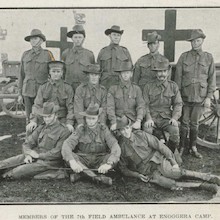
William Henry SMITH
| Rank | Reg/Ser No | DOB | Enlisted | Discharge/Death | Board |
|---|---|---|---|---|---|
| Pte | 6582 | 25y7m | 22 Sep 1915 | 6 Aug 1916 KA | 1 & 7 |
Private William Henry Smith (1890 - 1916)
Family and early life
William Henry Smith (Harry) was born in 1890 at Wolumla, New South Wales, son of George and Sarah Jane Smith. He attended the Public Schools at Wolumla in the Bega District and Federal in the Northern Rivers District of New South Wales. He became a carpenter.
Enlistment and service
On 22 September 1915 Harry Smith enlisted in Brisbane to serve in the Australian Imperial Force. His father, then living at Kooraville, Boundary Street, South Brisbane was his next-of-kin. Aged 25 years 7 months, nearly 6 feet tall (182.88 cm) and weighing 161 lbs (73kg), Private Smith was allotted to the 7th Field Ambulance at Enoggera Camp. His religious denomination was recorded as Methodist and he was working prior to enlistment as a stationer.
Private Smith, Regimental Number 6582, embarked with 7th Reinforcements on 30 December 1915 from Brisbane on board HMAT Itonus, arriving at Zeitoun, Egypt in early March. On 19 March 1916 he arrived at Marseilles in Southern France, having travelled per SS Minneapolis from Alexandria for service on the Western Front.
The 7th Field Ambulance was the Field Ambulance Company that served the 7th Brigade of the 2nd Division which was engaged in heavy fighting at the key position of Pozières in July/August 1916. The 7th Field Ambulance Company soldiers were responsible for 'Second Line' casualty evacuation from 'First Line' Regimental Aid Posts (RAP) in each battalion.
They would have to deploy forward to reach the RAP, and thus come under the same risks as the front line combat troops. Their work helping the wounded was very dangerous, exposing them to enemy direct fire from rifles and machine guns and the indirect fire of artillery mortar guns and even gas, often resulting in serious injury and death.
Soldiers with serious wounds who needed surgery had what was called "The Golden Hour" to receive the treatment they needed. After that time their chance of survival diminished rapidly. Conditions were such that evacuation times were extended considerably by poor weather, the predominance of water, mud, the detritus of battle, shell torn ground and enemy action. At the time infection was also a great risk as it was prior to the discovery of penicillin and other antibiotics.
Killed in action
Under these circumstances, Private Harry Smith was killed in action on 6 August 1916. Another brave 7th Field Ambulance soldier, Private George Harold Griffiths of Rockhampton described what happened:
“This man and I were out together between the first and second line of trenches, captured by our boys the previous night, that is on 4 and 5 August.
“We were out in the afternoon of the fifth attending to the wounded, and we had two patients that we were looking after but one of them was carried away by two stretcher-bearers and the other patient we had in a shell hole. This was at Pozières. A shell came over and killed Pte Smith who was with me. The patient had been out from the previous night and I stayed with him in the shell hole the night of the 5th with Pte W. H. Smith lying dead beside us. The patient died from exhaustion very early next morning so I was left alone.
“Pte Smith had asked me previously to take a certain wallet out of his pocket in order to send to his people in case anything happened to him, and I have worried since, because I could not do it, because I was wounded. The next morning I crawled up to the top of the shell hole and attracted some attention and so got back. Pte W. H. Smith was a fine big fellow. His father lives at Kooraville, Boundary Street, S. Brisbane, Queensland I think. I do not know the name of the patient.”
The informant was Private George Harold Griffiths who was being treated for injuries in No. 13 General Hospital at Boulogne at the end of the month of August1.
Harry’s mother correctly recorded her son’s courageous deeds:
“Organised a party who voluntarily went out into No Man’s Land to attend and bring in wounded men; killed while attending a soldier; mentioned in despatches 26 August 1916; recommended for Distinguished Conduct Medal.”
In her letter dated 3 November 1916 to the Officer-in-charge, Base Records, Mrs Smith said:
“… and you can understand my anxiety to obtain my son’s wallet. Kindly do all that you can to assist me in this matter.
Thanking you in anticipation,
Mrs Sarah J. Smith.”
It is unlikely the wallet was located.
A simple bronze plaque dedicated to the officers and men of the 7th Australian Field Ambulance is located at the Shrine of Memories in Anzac Square, just a few steps from Saint Andrew’s. It honours their service in defence of their country. Private William Henry Smith is remembered at the Villers-Bretonneux Memorial in France.
Select Bibliography
Compiled by Noel Adsett, Brisbane. 29 April 2015 ©

SLQ Historypin – Linking our digital stories to the world.
The Lives, Links and Legacy Stories are being shared through the State Library of Queenland's QANZAC 100: Memories for a New Generation Historypin Hub. Visit this site:
Know anything about this person or want to contribute more information?
Please contact Miriam at staheritage@gmail.com








